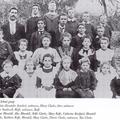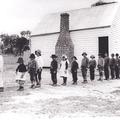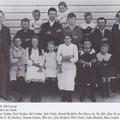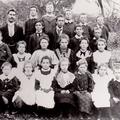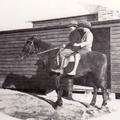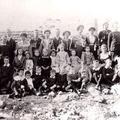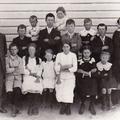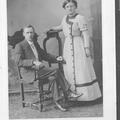< Early Canberra Government Schools
Glenwood [1883 - 1934]
On 20 November 1882 a group of residents of the Parish of Wallaroo submitted an application for the establishment of a public school at Glenwood. The application was signed by William George Hildred, Alexander Boyd, Samuel Southwell, John Joseph Baines, Martin Joyce, Lachlan McPherson, Francis Coulton, Patrick Coulton and David Rule. Their children were Baines: Alf (12), Emily (10), Mary Ann (8), Benjamin (6). Boyd : Patrick (13), David (11), William (8), Robert (7), James (5). Coulton: James (13), Ann(12), Cecily(11), Agnes(9), Charles (7), John (7), Anne (5). Hildred: George (13), Andrew (11), Eliza (9), Albert Henry (7). Joyce: Emily (7). McPherson: James (10), Albert (8), Flora (6). Southwell: Hubert (12), Horace (11), Ben Richard (8), George (5). Rule W.
Other family names of children who attended Glenwood School in the early days were Blundell, Clarke, Gee, Rochford and Rolfe.
The Minister for Public lnstruction decided in March 1883 to establish the school and it opened later in the year. Following an application by local families for a grant of land on which to build a school, Glenwood School site was dedicated on 18 January 1884 and valued at fifteen pounds. Eleven eucalypts were marked to indicate the boundaries.
The school commenced in a slab building (20ft by 13ft) with a shingle roof, unlined and built with community help. lnitially there were 24 boys and 11 girls enrolled with an average weekly attendance of 27. The first teacher, Alexander Elliott, extended the hut by 10 feet at a cost of 25 pounds.
Additions were made to the school and grounds in 1884 by James Rolfe, by providing two toilets, two windows and two 7 foot long desks for twenty five pound. lt was described as inadequate.
"The present building is an inferior slab and bark one which leaks in numerous places every shower. ln winter it is entirely too cold for children to be in and several children died last winter through cold caught in attending it, and they are famished in summer due to no water."
Following parent complaints, a more substantial school was approved and completed in 1897 for seventy five pound, ten shillings. It had a galvanised iron roof, a fireplace (which was replaced but never successful) and outer walls. A further 5 acres were resumed in 1907 to provide a school paddock. Mr G.K. Kinlyside lined the building at a cost of thirty pound in 1908.
Long term teacher William Alexander was warmly acknowledged when he was promoted to a Sydney school in 1907:
Mr. W. A. Alexander, who has been in charge of the Glenwood Public School for the past ten years, has been promoted as an assistant to the Newtown Superior Public School Mr. Alexander's long residence in this neighbothood gained for him the respect of all classes. As a teacher he was deservingly highly thought of by parents, for his whole heart was in his work, which was always his first consideration. His gentlemany unassuming manner made him exceedingly popular and his many friends, while feeling pleased at his promotion, will regret exceedingly his departure from our neighborhood.[Queanbeyan Leader, 10 May 1907, p2]
Mr James N. Gormly and his wife lrene Pratt were the last teachers when the school closed in 1934. The building was later moved to 'Forest View' where it was again used as a school house for 2-3 years for the children of Alexander Gregory (Greg) Rochford and grandchildren of Mary Ann Baines. lt was then known as Bennetts Creek School. It was finally moved to Nanima Tennis Club.
School Life - Jim Rochford, former pupil
Mr Jim Rochford of Hall attended Glenwood School under the supervision of the last teachers at that school, Irene Pratt and James Gormley. Jim started school at six years old and left in December 1927, aged14.
Of some of the other pupils, Jim said "Frank Rolfe, a cousin of mine came from Bedellick. The Clarkes came from the Dog Trap Road area and walked 3 miles. Some crossed the Murrumbidgee River to go to school. lf the creek was up the Wilson children stayed overnight with us and mother packed lunch for us all. Bob Jordan rode seven miles on a pony and had to open about eight gates. He lived out near 'Springfield' and had his ears eaten off with chillblains! Many of the children walked up to 5 miles to attend and after the closure of a half-time school at Gooda Creek, travelled on horseback or sulky for over 7 miles.
At exam time those eligible to take exams gathered from small schools to Hall Public School. lt was the senior school with the most pupils with Charles Thompson as teacher. Those from Glenwood that sat the exam at the same time as me were Tom Rolfe, Zena Rochford, Bernie Rochford and the girl Butt who stayed the night before with the Morris's as her mother was a Morris. I was shy and too frightened to pass because it meant I would have to go away from home."
"..............it was never a comfortable place in which to study but nevertheless excellenf scholastic results were achieved by many who attended this school, in itself a tribute to the endeavour, determination and will to succeed displayed by teachers and pupils under very difficult conditions. During the stewardship of teacher Mr William Alexander 1897 - 1907, Mr P.F. Sheehy, lnspector of Schools, reported that the handwriting of pupils at Glenwood Sctrool was the best of any in his Inspectorate."
Sadly, after the deaths of two Blundell and two McPherson children from diphtheria, all pupils of the school, Glenwood closed for a time.
"...............the highest attendance was about fourteen pupils. A one teacher school, all classes were taught in the same room and they were very efficient teachers, we thought in that time, although most of us didn't like going to school because we liked the wild run around bush style. We all worked on our little farms or home before we went to school, fed animals, cut wood, prepared things so we had a fairly long day. We had to go home and do our homework. We used to fall asleep doing our homework. We had sports. lt was a rocky little knob where we went to school so it wasn't conducive to having a good cricket field. The citizens and friends built a tennis court for us. The great problem was for us to get enough money to buy tennis racquets. We went along with what we had for ordinary, everyday use and with lunch in a little calico bag, which we would hang it up in a bush shed made of little bush poles. That was a little garden shed as well. The teachers had a garden to grow plants and so on."
Glenwood School picnic 1905
The picnic in connection with the Glenwood Public School on Wednesday last attracted a large crowd from all parts of the district. The parents in this locality are noted for a genial open heartedness common to Australian bush life, and on this account the place is highly popular. Mr. W. Alexander, the teacher, is a general favorite, and worked in a cheerful manner towards promoting the enjoyment aud comfort or visitors. He was ably assisted by the good ladies of Glenwood whom I do not care to particularise, in case I should make accidental omissions. The prizes were numerous and the athletic events were keenly contested. The dinner provided was excellent, and the way some of us laid our ears back and attacked the good tidings was an eye-opener. The dance at Mr. Alex. Rochford's at night ended a pleasant day.
[Friday 2 June 1905. Queanbeyan Leader]
Glenwood School's Jubilee Celebrations on Empire Day
Empire Day celebrations at Glenwood were carried cut as usual in co-operation with parents and citizens. Particular interest was aroused i the function this year as the fiftieth Anniversary of the school occurred early this month. A special effort was made to have as many past pupils in attendance as possible on the day. The Glenwood school was opened in May, 1883, with Mr. Elliott in charge. Quite a large number of pupils attended on the first day, from little ones of five and six, to young men and women in their late teens.
The first building was of bark and slabs, with an old fashioned big fireplace and was situated just in front of the present school which was erected some five or six years later. It was of great interest to have present at. this year's function two of the pupils present on the birthday of the school, namely Mrs. C. Clarke and Mr, George Southwell. The morning proceedings at the school opened before a good gathering of pupils (present and past), parents and citizens. The teacher, Mr J. Gormly, expressed pleasure at having such a fine gathering at the ceremony. He welcomed those present and expressed a hope that the bys and girls would have a very enjoyable day. It was particularly pleasing to him to see two of the original pupils, Mrs. Clarke and Mr. George Clarke, at the fiftieth birthday of the school. The present pupils were trying, in honour of the event, to make this year a special year in the progress of the school.
Their success in obtaining ten prizes at the Yass Show this year, and in aggregate of 50 prizes at local shows within the last few years was an effort to show that they were keeping, up the 'best traditions of the school. It was his wish to congratulate the parents on the success of the. Children and to invite inspection of the prizes that were to be seen in the school. The teacher then asked Mr. George Southwell to give an address. Mr. Southwell, in his address, said that he considered it an honour to be called upon to give a speech on this occasion in such a fine old school, he well remembered the day. Of its opening when he was only a small child among many bigger and older boys and girls.
Mr. Southwell then gave some reminiscences of the early days of the school, "these, as well as being very fitting for the occasion, were very much enjoyed by both young and old. In proceeding with his remarks on Empire Day, Mr. Southwell drew attention to the importance of the Empire's position as the leader in world affairs, The Welfare of the Empire, he said, was also the welfare of the world. The work of keeping the Empire in this proud position, which at present falls upon the men and women of today, must soon be borne by the boys and girls who are at school now, and who will be the men and women of tomorrow. He urged the boys and girls to strive each day to make themselves better, both morally and physically, in order that they may be fit to carry on the great work of Empire.
In moving a vote of thanks to Mr Southwell for his fine address, Mr. Gormley said that he had enjoyed the address thoroughly and was sure that everybody had enjoyed it "equally as well. It was very pleasing", he said, "to see an old pupil, of the school give such an able address. The vote of thanks was carried very heartily by acclamation. The pupils then presented, for the benefit of visitors, a dramatisation of Walter Raleigh and Queen Elizabeth, in which, Raleigh so gallantly covered a pool in the street for the Queen to cross. The presentation was thoroughly enjoyed by both children and adults. Proceedings in the school closed with the singing by pupils of the Recessional Hymn, Advance Australia Fair and the National Anthem.
To celebrate the birthday of, the school, Miss M. Clarke made and donated a double decker, cake with fifty candles upon it. Her mother, Mrs. C. Clarke, who was the oldest ex-pupil present, had the honour of blowing out the candles and cutting the cake. Each ex-pupil was presented with a. candle as a souvenir. The. remainder of the day. wa spent in the playground at games and races. While the pupils were engaged at the games, the younger people kept the two tennis courts in full swing, and older folks did not let such a good chance for a long chat pass unused. At the conclusion of the children's games, contests were held, for the grown ups. Altogether the day was a very happy one for young and old alike. The concluding event, a lolly scramble, was welcome by everyone, the older folk joining in and enjoying it as much as the children.
[Queanbeyan Age, Tuesday 16 May 1933, page 2]
Location Map
Related Photos
Teachers
- Elliot, Mr Alexander
04/1883 - 09/1889 - Kiernan, Mr Patrick
09/1889 - 02/1894 - McDonald, Kate
05/1894 - 06/1895 - Faulder, Mr William Patrick
06/1895 - 12/1896 - Alexander, Mr William
02/1897 - 06/1907 - O'Connell, Mr Michael
06/1907 - 10/1908 - Try, Mr John F.
10/1908 - 06/1916 - McLaughlin, Mr P.G.
06/1916 - 12/1917 - Murray, Mr Rowland C.
01/1918 - 06/1918 - Shreeves, Mr Walter
07/1918 - 07/1919 - Hinde, Mr James
07/1919 - 05/1922 - Pratt, Irene
05/1922 - 05/1926 - Gormly, Mr James
08/1926 - 12/1934
NSW Government schools from 1848
- Glenwood (external link)
< Early Canberra Government Schools
If you are able to assist our work of identifying, documenting, and celebrating the early bush schools of the Canberra region, please contact us or .


